An outstanding canvas: The colors and creed of Zhang Xian
- By staff reporter Li Yuan
 0 Comment(s)
0 Comment(s) Print
Print E-mail China Today, September 20, 2016
E-mail China Today, September 20, 2016
During Bonjour Brand 2016, the annual forum in May, to facilitate the pairing of Chinese companies with French ones, former French Prime Minister Jean-Pierre Raffarin received a surprise gift. It was a scroll painting by Zhang Xian, the Chinese artist who has evolved his own style of combining elements of Western and Eastern art. It was a doubly welcome present since five years earlier, Raffarin had added to his collection an oil by the same artist.
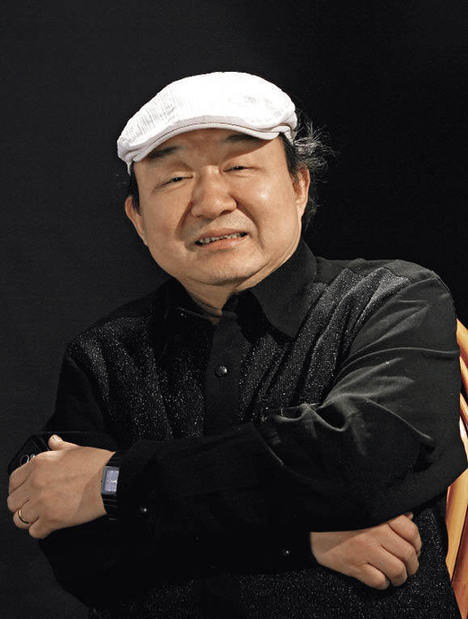 |
|
Artist Zhang Xian. |
A prime pillar of Chinese culture, Chinese paintings convey distinctive Chinese thoughts, conceptions, and aesthetics, and are appreciated worldwide as a gem of world culture. Zhang Xian stands out for his ingenious combination of the fundamentals of Chinese ink painting with the color scheme and sketching techniques of Western oils. The result is a style with nuanced grace and flamboyant colors, acclaimed both in and outside China.
Buddhism Meets Taoism
Zhang was born into an artist family in Beijing in 1954. His grandfather Zhang Meicun had studied with Zhang Daqian (1899-1983), one of China's most prestigious 20th-century artists. His father Zhang Yuncheng was a disciple of Xu Linlu (1916-2011), a master of the Qi School, the style founded by Qi Baishi (1864-1957), who focused on small objects and is celebrated for his paintings of shrimps. Following in their footsteps, Zhang began to learn drawing from a young age, receiving a solid grounding in traditional Chinese painting techniques, which won him kudos among art connoisseurs worldwide.
At the invitation of the mayor of Traunstein, a town in Germany, Zhang exhibited his work in the city council in 1999. During the exhibition, he made friends with many famed European artists, and learnt from their conversations that Chinese painting elements were no longer a rarity in European painting. It inspired him to create a new genre by blending the two.
In the next seven years, Zhang toured Europe to study European art, perusing, contemplating, and experimenting with a view to an inspirational collaboration between Eastern and Western cultures. This effort yielded a new genre – oil and ink painting – which combines oil's expressivity with ink's spirituality.
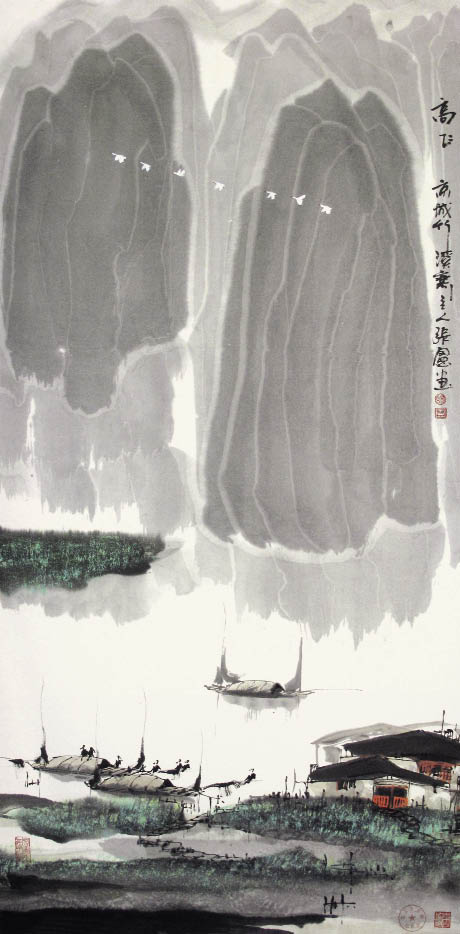 |
|
Fly High, which traveled with Shenzhou-9 space craft. |
Versed in Buddhism, Zhang chose the lotus, a Buddhist symbol, as his favorite subject, depicting it with the buoyant colors of the West but in the subtle manner of Chinese brushwork. His flowers might be in realistic rosy pink or surrealistic cobalt blue, rising above a splash of varied green, which represents the leaves. This unconventional rendition enhances the classic charm of this sacred flower of Buddhism.
Zhang also employs his understanding of Taoist naturalism in his creations. This explains the spiritual, spatial quality of his works that denotes love of life, nature, harmony, and positivity. While various viewers may interpret the same painting differently, it speaks to their hearts.
Zhang's oil and ink genre created a sensation among Chinese artists. Poet Zeng Li described him as: "Blazing the trail and a peerless pioneer of painting mountains, rivers, and clouds." Yu Feng, vice chair of the World Association of Chinese Artists, lauded Zhang's works for their poetic Oriental appeal and subtle Occidental chiaroscuro, which combined to create a refreshing visual effect. Art critic Da Hai called Zhang's new style a trans-cultural and trans-art phenomenon amounting to a revolution in the history of Chinese painting.
State Gifts
In 2004, Zhang Xian's Water Town was selected to decorate China's Air Force One, the aircraft used by the head of the state. Two other paintings by him, The Yellow Mountain and Lotus, were chosen the next year. His works have also made it to the list of state treasures gifted to foreign dignitaries.
In December 2009, when then Chinese President Hu Jintao and his wife Liu Yongqing were going to the 10th anniversary celebration of Macao's return to China, the media published images of them waving to the crowds while deplaning. Zhang's painting, The Red Lotus Blossoms in a Prosperous Time, could be seen behind the couple.
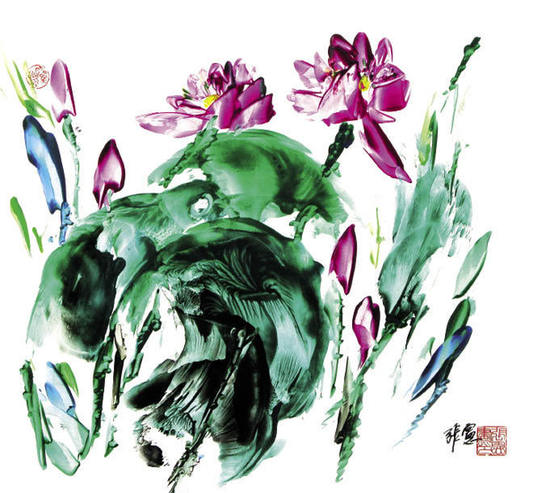 |
|
The Red Lotus Blossoms in a Prosperous Time. |
When China's manned spacecraft Shenzhou-9 was launched on June 16, 2012, it carried 10 works by Chinese artists, including Zhang Xian. After 13 days in space, the vehicle and its art treasure trove returned safely to Earth. To honor Zhang's contribution to China's space program, the national space administration presented him with a medal and an astronaut's space suit.
Zhang Xian's oil and ink paintings became better known to the public in 2015 after his The Value of Harmony appeared in a public-interest advertisement aired by China Central Television. This painting now features in a poster widely seen on the Beijing metro.
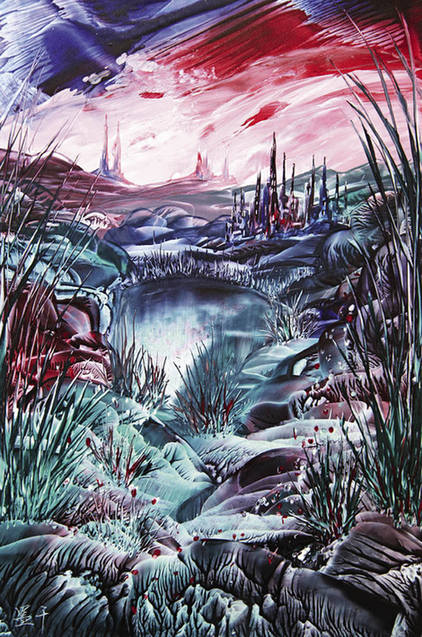 |
|
Castle in the Woods. |
From Air Force One to public transport, Zhang Xian's oil and inks are appreciated by statesmen and the common people alike. As one art critic commented: "This attests that the artistic value of Zhang's works is widely recognized, and what's more, [that] this young genre of oil and ink painting is well established in Chinese art."
Inheritance and Innovation
The lotus, Zhang's favorite subject, stands for chastity and modesty in Chinese culture. It also embodies the personality of the artist who takes fame and fortune lightly. His philosophy is that when choosing painting as one's career, one must be prepared to endure poverty and loneliness and persevere in one's artistic pursuit. That's the teaching of his father, which Zhang has passed on to his own son, Zhang Moqian, who is also a painter and his pride and joy.
 |
|
Painter Zhang Moqian in Venice. |
A graduate of Tsinghua University's Academy of Arts and Design, Moqian has different perceptions from his father's generation. He thinks pencil sketches are a good foundation for abstract art and that an artist's merit lies in an individualistic style. To draw inspiration from other cultures, Moqian has traveled to more than 20 countries and regions around the world, from the Himalayan kingdom of Bhutan to Vienna, Europe's cultural capital. Commuting between Eastern and Western civilizations the young painter is developing his own vision of art, and has created a subgenre of oil and ink painting distinct from that of his father.
At the invitation of Guan Qige, executive chairman of the World Association of Chinese Artists, Moqian will undertake a global tour later this year, exhibiting select works. Some international fashion brands have expressed interest in incorporating his work into their products.
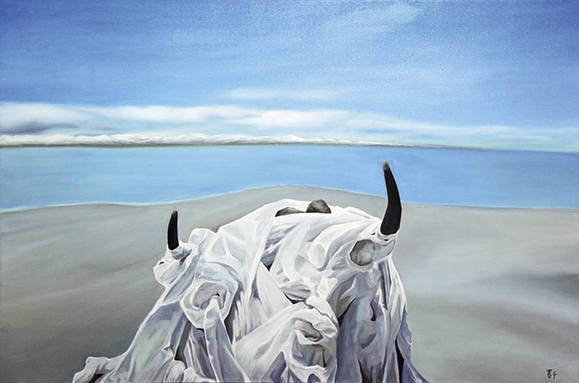 |
|
Yak and White Hadas. |
Besides the lotus, Zhang Xian has delineated other natural elements such as the Himalayas and the headwater region of the Yangtze River. He has depicted man-made elements as well, like the ruins of the ancient city of Loulan in Xinjiang, and the Potala Palace in Tibet. With soulful strokes and bright colors, Zhang distillates the defining features of natural sights – the awesome strength of a mountain or the mesmerizing spiritedness of a river. In the bosom of nature Zhang Xian feels his heart is at rest and his mind set free.
Zhang is also known for his philanthropy. In 1990, he and calligrapher Tian Boping donated the proceeds of their joint exhibition to the 11th Asian Games. He has also given his paintings to charity auctions and programs, such as that for survivors of the devastating earthquake in Wenchuan in 2008. As media commentator Huang Zhenzhong said: "Without a noble moral character, a painter cannot create thought-provoking, soul-touching works. Only painters who are deeply concerned about their country and people and can keep pace with the zeitgeist can stand at the forefront of time and the arts, and make artistic expressions that can send echoes down history."
Zhang Xian has an album of works by earlier generations of his family. These sepia pages are a treasure trove to him and his son, offering them fresh inspiration with each viewing. It is a living reminder of the mandate of their ancestors – to continue the family tradition and promote the best of national art, a mission the duo has pursued unswervingly.






Go to Forum >>0 Comment(s)